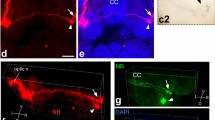Abstract
The eyes of zebra finches are placed laterally, the foveae are looking into different directions. It is unlikely that the birds are able to process different images from both eyes simultaneously. A neural mechanism might therefore be necessary to guide the birds' attention to one of the two eyes and to reduce the processing of information of the other. Previous studies revealed that information from the ipsilateral eye is indeed suppressed on its way to the telencephalon by the activity of the contralateral eye. It has been suggested that two nuclei of the tecto-thalamic tract, nucleus subpraetectalis and nucleus interstitio praetecto subpraetectalis, are a central part of such a suppressive mechanism. Using electrophysiological recordings, we investigated the influence of these two nuclei and nucleus rotundus on the processing of binocular visual information by treating the nuclei with picrotoxin or electrolytic lesions. Deactivation of inhibitory neurons within SP/IPS leads to a significant increase of the ectostriatal responses to ipsilateral and bilateral stimulation, the responses to contralateral stimulation remain unaffected. Lesioning SP/IPS does not alter the responses to visual stimuli. Treatment of nucleus rotundus with picrotoxin increases contralaterally and bilaterally, but not ipsilaterally evoked responses. A wiring diagram is presented which interprets these findings.









Similar content being viewed by others
References
Benowitz LI, Karten HJ (1976) Organization of the tectofugal visual pathway in the pigeon: a retrograde transport study. J Comp Neurol 167:503–20
Bischof HJ (1981) A stereotaxic headholder for small birds. Brain Res Bull 7:435–436
Bischof HJ (1988) The visual field and visually guided behaviour in the zebra finch (Taeniopygia guttata). J Comp Physiol A 163:329–337
Bischof HJ, Niemann J (1990) Contralateral projections of the optic tectum in the zebra finch. Cell Tissue Res 262:307–313
Bloch S, Lemeignan M, Martinoya C (1986) Coordinated vergence for frontal fixation, but independent eye movements for lateral viewing, in the pigeon. In: O´Regan JK, Lévy-Schoen A (eds) Eye movements: from physiology to cognition. Proceedings of the Third European Conference on Eye Movements, Dourdan, France. Elsevier North Holland, Amsterdam
Bredenkötter M, Bischof HJ (1990) Differences between ipsilaterally and contralaterally evoked potentials in the visual wulst of the zebra finch. Vis Neurosci 5:155–63
Cohen DH, Karten HJ (1974) The structural organization of the avian brain: an overview. In: Goodmann IJ, Schein MW (eds), Birds, brain and behavior. Academic Press, New York, pp 29–73
Deng C, Rogers LJ (1998) Organisation of the tectorotundal and SP/IPS-rotundal projections in the chick. J Comp Neurol 394:171–85
Denton CJ (1981) Topography of the hyperstriatal visual projection area in the young domestic chicken. Exp Neurol 74:482–498
Engelage J, Bischof HJ (1988) Enucleation enhances ipsilateral flash evoked responses in the ectostriatum of the zebra finch (Taeniopygia guttata castanotis Gould). Exp Brain Res 70:79–89
Engelage J, Bischof HJ (1989) Flash evoked potentials in the ectostriatum of the zebra finch: a current source density analysis. Exp Brain Res 74:563–572
Güntürkün O, Melsbach G, Hörster W, Daniel S (1993) Different sets of afferents are demonstrated by the fluorescent tracers fast blue and rhodamine. J Neurosci Methods 49:103–111
Karten HJ, Mpodozis J (1997) Two distinct populations of tectal neurons have unique connections within the retinotectorotundal pathway of the pigeon (Columba livia). J Comp Neurol 387:449–65
Karten HJ, Shimizu T (1991) Are visual hierarchies in the brains of the beholders? Constancy and variability in the visual system of birds and mammals. In: Bagnoli P, Hodos W (eds)The changing visual system: marturation and aging in the central nervous system. Plenum Press, New York, pp 51–59
Leminski S, Bischof HJ (1996) Morphological alterations of the visual system in white zebra finches. Neuroreport 7:557–561
Levelt WJ (1967) Note on the distribution of dominance times in binocular rivalry. Br J Psychol 58:143–145
Macko KA, Hodos W (1984) Near-field acuity after visual system lesions in pigeons. I.Thalamus. Behav Brain Res 13:1–14
Mpodozis J, Cox K, Shimizu T, Bischof HJ, Woodson W, Karten HJ (1996) GABAergic inputs to the nucleus rotundus (pulvinar inferior) of the pigeon (Columba livia). J Comp Neurol 374:204–222
Niemann and Bischof 1990
Perisic M, Mihailovic J, Cuenod M (1971) Electrophysiology of contralateral and ipsilateral visual projections to the wulst in pigeon (Columba livia), J Neurosci 2:7–14
Pettigrew J D, Konishi M (1976) Neurons selective for orientation and binocular disparity in the visual wulst of the barn owl. Science 193:675–678
Remy M, Güntürkün O (1991) Retinal afferents to the tectum opticum and the nucleus opticus principalis thalami in the pigeon. J Comp Neurol 305:57–70
Schmidt A, Bischof HJ (2001) Integration of information from both eyes by single neurons of nucleus rotundus, ectostriatum and lateral neostriatum in the zebra finch (Taeniopygia guttata castanotis Gould). Brain Res 923:20–31
Tömböl T, Németh A, Sebestény T, Alpár A (1999) Electron microscopic data on the neurons of nuclei subpretectalis and posterior-ventralis thalami. A combined immunohistochemical study. Anat Embryol (Berl) 199:169–183
Acknowledgements
Our thanks are due to Onür Güntürkün for a helpful discussion on the topics presented in this publication. The original research reported here was performed under guidelines established by the German Welfare Law and was permitted by the responsible state authority. Supported by the Deutsche Forschungsgemeinschaft (Bi 245/15).
Author information
Authors and Affiliations
Corresponding author
Rights and permissions
About this article
Cite this article
Voss, J., Bischof, HJ. Regulation of ipsilateral visual information within the tectofugal visual system in zebra finches. J Comp Physiol A 189, 545–553 (2003). https://doi.org/10.1007/s00359-003-0430-2
Received:
Revised:
Accepted:
Published:
Issue Date:
DOI: https://doi.org/10.1007/s00359-003-0430-2




